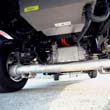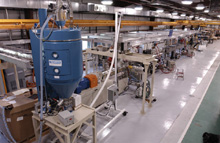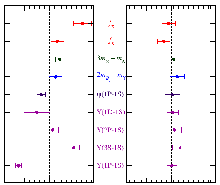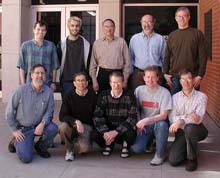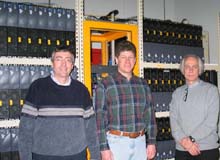 | Thursday, February 12, 2004 |
|
Thursday, February 12 1:30 p.m. Electrical/Electronics Safety Seminar - Curia II Speaker: D. Robley, Fluke Corporation Title: Digital Multimeter Safety Training Course: Learn How to Identify and Avoid Electrical Measurement Hazards 2:30 p.m Theoretical Physics Seminar - Curia II Speaker: D. Rainwater, DESY Title: Higgs Pair Production and the Higgs Potential 3:30 p.m. DIRECTOR'S COFFEE BREAK - 2nd Flr X-Over THERE WILL BE NO ACCELERATOR PHYSICS AND TECHNOLOGY SEMINAR TODAY
Friday, February 13 |
|
Thursday, February 12 Old Fashioned Tomato soup Chicken parmigana w/pasta and marinara $3.50 Assorted gourmet sandwiches and panini $4.75 Baked tilapia w/a pineapple chipotle sauce and coconut cous cous $3.50 1/2 pound burger w/bacon, Thousand Island and pickles on grilled sourdough $4.75 Rustic chicken salad over wild greens w/fresh fruit $3.75 Eurest Dining Center Weekly Menu Chez Leon |
|
Extended Forecast |
Secon Level 3 |
| Fermilab Today is online at: http://www.fnal.gov/today/ Send comments and suggestions to today@fnal.gov Fermilab Today archive Fermilab Today classifieds Subscribe/Unsubscribe to |
Fermilab Wins Two Environmental Awards
With an increase in the number of alternative-fuel vehicles and the installation of on-site refueling facilities, Fermilab saved over 10,000 gallons of petroleum in FY03. The Office of Science recognized George N. Davidson, Jeffrey W. Irvin, Gregory B. Mitchell, Brian K. Niesman, Randall G. Ortgiesen, and Jeffrey A. Sims for their commitment to the Fermilab Alternative Fuel Initiative. Jose De La O, Anna Pla-Dalmau, Dale R. Wilderspin, Scott K. Borton, John J. Kelly, and Eric McHugh were recognized for their efforts in the Scintillator Plastic Recycling Program. The Plastic Scintillator Extrusion Line, installed in the spring of 2003, produces 3,000-6,000 pounds of waste a month. These workers recognized the problem and found a local vendor that could accept 100% of the waste plastic. Amy Pavnica, chair of Fermilab's Environmental Protection Subcommittee, calls this an example of "good old-fashioned recycling." The honorees will be officially recognized at an awards ceremony in the Spring. | ||
|
|
February 9 - February 11 - Operations established one store during this period. That store along with an existing store, provided approximately 44 hours and 3 minutes of luminosity to the experiments. - The I- Source suffered from sparking and trips - Recycler took transfers of antiprotons View the current accelerator update View the Tevatron Luminosity Charts |
|
From Nature, February 12, 2004 Particle physics: Lattice window on strong force By Ian Shipsey A long-awaited breakthrough has been made in lattice quantum chromodynamics — a means of calculating the effect of the strong force between sub-atomic particles that could, ultimately, unveil new physics.
The fundamental particles called quarks exist in atom-like bound states,
such as protons and neutrons, that are held together by the strong force.
The heavier varieties of quark, such as the bottom quark, can disintegrate
to produce other, lighter particles, and the pattern of the decay rates is
constrained, but not determined, in the theory of fundamental particles,
the standard model. That pattern, especially the part involving the bottom
quark, is sensitive to new physical phenomena. But although accurate
measurements of the rates have been made, the window on new physics
has been obscured. This is because the binding effect of the strong
force between quarks modifies the decay rates: unless correction factors
can be accurately worked out, the data cannot be fully interpreted for
signs of any physics that is as yet unknown. This has been the case for
almost 40 years. But at last, Davies et al. report an advance in lattice
quantum chromodynamics, a method of calculating the effect of the strong
force, that promises the calculational precision required (C. T. H. Davies
et al. Phys. Rev. Lett. 92, 022001; 2004).
|
|
26 Theorists + Computer Clusters = Progress in Lattice QCD | ||
|
For nearly 30 years, theorists have tried to calculate properties of
particles containing quarks directly from the basic
equations of quantum chromodynamics (QCD). The most promising
approach is called lattice gauge theory, but it requires a
lot of computing power. So, starting in November 2000,
Fermilab's Computing Division began to build clusters of PCs
for lattice QCD. The clusters now contain 512 processors,
which together are about 6 times faster than the lab's special-purpose
ACPMAPS computer built in the 1980s.
Although computers are getting faster, until recently many theorists continued to use the so-called quenched approximation, a rather drastic simplification of QCD. Now 26 lattice gauge theorists-unusually many for a theory paper-have published evidence that a new method, called improved staggered fermions, allows them to scrap the quenched approximation, yielding much better results. Past lattice QCD calculations have agreed with experimental results within 10 to 15%. Although this is pretty good, such results are insufficient for precision measurements obtained by today's experiments. Using the new method, the 26 theorists have achieved agreement with experimental data for a wide variety of hadrons (see above graphic). Lattice theorists now begin to make precise predictions of future measurements of particle properties.
Because the full range of results was far more impressive than any individual one, all 26 theorists joined forces and wrote one paper. Read a related story in Nature, which is also featured in today's issue of Fermilab Today. | ||
|
Read more: Physical Review Letters: High-Precision Lattice QCD Confronts Experiment Nature: Particle physics: Lattice window on strong force Result of the Week Archive |
|
Fermilab's Gallery Chamber Series The Fermilab Gallery Chamber Series will present the Baroque Trio Sonatas on Sunday, February 29 at 2:30 p.m. in the 2nd floor art gallery. more information
Recreation Adult Outing |
